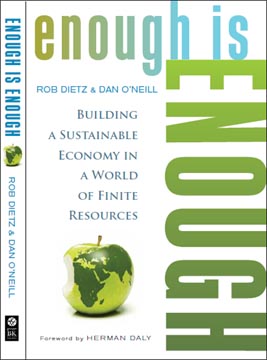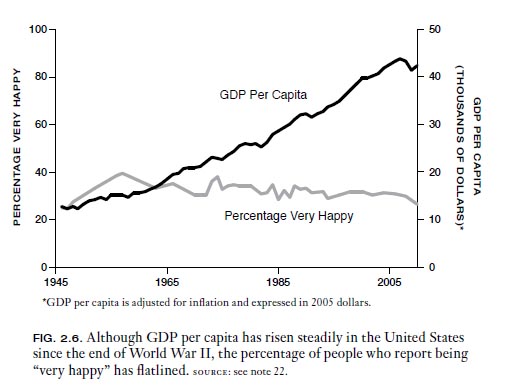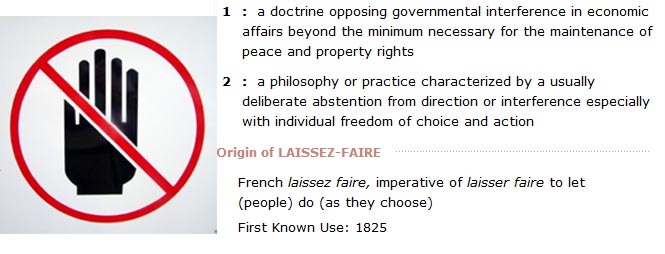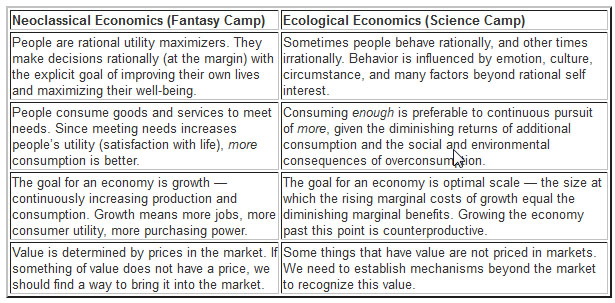Thanksgiving, the celebration of bounty, seemed a completely appropriate time to contemplate the corollary concept of enough. Hence one of my tasks for the weekend (why do I always think a day or two off, or even a long plane flight, will give me the time to catch up on everything?) was to read the advance copy of Enough Is Enough sent me by co-author Rob Dietz. A bit overoptimistic I was. I’ll blame the lingering L-tryptophan effect. But I’ve only missed the goal by a bit.
Dietz is the executive director of an organization called CASSE or the Center for the Advancement of the Steady State Economy, a mouthful as large as the (first) slice of leftover pumpkin pie I had for breakfast on several of the days following the feast. “Enough Is Enough” rolls off the tongue much more easily (than CASSE, not pumpkin pie), and the strong, memorable title makes me almost wish CASSE would change its name to accompany the book.

The basic tenet of the steady state economy (or SSE) is an observation that makes complete sense: you can’t have infinite growth in a finite system. Unfortunately, conventional economics – perhaps in an attempt to defy its characterization as the dismal science – says otherwise. Its faith in unending growth portrays it as both possible and desirable.
EcoOptimism, though based (obviously) in optimism, doesn’t subscribe to this delusional belief in the virtues of growth. In another post, I’ll discuss how that self-serving faith is actually more akin – as faith-based ideas tend to be – to a religion than it is to a science. So much so that, in attempting to escape the “dismal science” moniker by being less dismal, conventional economics may have instead lost its reasoned science aspect.
What’s in a name?
Part of the politically untouchable faith in growth derives from the positive nature of the word growth. How could growth possibly be bad or undesirable? And, even after proving that it is, finding an appealing word or phrase to convey that idea is a difficult task, yielding less than positive terms. Ungrowth? Uh uh. Degrowth? No better. Is the opposite of growth diminishment? Nothing appealing in that. Another suggested term, post-growth, gets warmer, but still doesn’t quite make the cut for me.
And so we get to steady state economics. Though it ain’t exactly catchy ( as noted above) SSE at least doesn’t succumb to easy connotations of negativism and survives the first round of sound bite tests. Steadiness, especially when compared to the booms and busts of recent history, has much to be said for itself.
Going Steady
But the goal of SSE is not so much to steady the rough ride of economic cycles as it is the creation of a path for continuing human growth within the constraints of an amazing yet finite planet. And it’s also more than (merely) achieving sustainability. It is the decoupling of economic growth from human flourishing. It is the enabling not just of a future, but of a positive future.
We already know that happiness (yes, I know that’s a mushy subjective quality, but there actually are ways to define and measure it) does not correlate with economic growth, at least not in the long run. In the richer nations (the “developed” world), where essential needs have largely been met, the acquisition of more material things does not lead to happier or more fulfilled lives. And acquiring things is, after all, an integral part of material growth and its measure, the appropriately named Gross Domestic Product. But even with this knowledge (which is not nearly widely enough known), how is the iconoclastic case against growth made? And accepted?

I have nearly the same image in my book, Sustainable Design: A Critical Guide, but this is from Enough Is Enough
There’s been a plethora of books on this topic of late. I’ve written about some of them before: Prosperity Without Growth, The End of Growth, Plenitude, eearth, et. al. But in virtually every case, what’s been missing from the iron-clad arguments has been an accompanying roadmap. We have a general idea of where we want to go, but no idea – especially not a convincing one – how to get there.
Indeed, this shortcoming is a major part of the purpose behind EcoOptimism. Along with the lack of concrete steps, I’ve been positing that we need verbal descriptions and perhaps graphic illustrations (I must still be in a Thanksgiving state of mind because that made me think of the “twenty seven eight-by-ten color glossy pictures with the circles and arrows and the paragraph on the back of each one” from Arlo Guthrie’s Alice’s Restaurant — but I digress) depicting what our un/re/de/post-growth future will look like.
Happily, Dietz and co-author Dan O’Neill have brought us much closer to answering the how-the-hell-do-we-get-there question. Each chapter in the section “Strategies of Enough” as well as most of the chapters in the third section “Advancing the Economy of Enough” begin by asking “What Are We Doing?” and proceed to “What Could We Do Instead?” Then they move to the part I devoured each time: “Where Do We Go From Here?”
Dietz and O’Neill are, of course, thoroughly familiar with the concepts of a Steady State Economy. But, they write, “we had been asking ourselves for some time how a steady-state economy would work in practice.” What are “the policies and transition strategies that would turn [a SSE] vision into a reality?” Those questions, as it happens, are the same ones I’ve been asking since I started focusing on the “New Economy.”
They’ve done a terrific job on the second question. First they demolish the conventional argument that growth is the solution to poverty, poor education and unrepresentative rule as well as pollution (the argument proffered by groups like the WTO and mainstreamed by Bjorn Lomberg’s The Skeptical Environmentalist). Toss out the convenient and misleading metaphor “a rising tide lifts all boats.” Our economic history strongly declares otherwise.
Responding to the Econ 101 tenet “Market prices give no reason to believe that natural resources are a limit to economic growth,” they almost literally scream “This statement may be true, but it reveals more about the failure of markets than the absence of limits!” This is the core of an argument many of us have been making in various forms for years: a “free” market can work only if everything is priced accurately. And our current markets, which consider almost every resource and service provided by nature to be free, are far from that point. “Prices often fail to capture the effect of resource depletion, waste generation, and loss of ecosystem services. As a result, the market sends improper signals—if it sends any signal at all—regarding the sustainability of throughput levels. We need to eliminate this market failure….”
What’s Enough?
Making economic growth the measure and the goal does humanity a huge disservice. Growth, in the gross unqualified version that we currently reflexively strive for, is a false god asking us to sacrifice everything (our lives, our planet) in search of a future nirvana that cannot possibly be the result. The problem, putting aside such relevant constraints as physics and, yes, economics, is that we’ve set our goal on the wrong sight. “More” is not only unachievable; it is undesirable. And the opposite of more is not less; it’s enough – provided that what we achieve enough of is what we in fact need to grow qualitatively. This becomes a two-part question: first, what is “enough,” meaning what sates us and leaves us better off than we started and, second, how do we get to that state?
We can continue the overly obvious Thanksgiving analogy here. For most of us, the quantity of the food leaves us with that content but overstuffed lagginess and perhaps the feeling that we overdid it. We certainly could live without it, though most of us would choose not to. Why? Because we enjoy the ritual, the company … and the food. What, more precisely, is it that makes the holiday so valued to so many? It’s not the amounts of food that we often wish we had exercised a bit more willpower to resist. It’s the circumstance, the associations and the experience (both social and sensorial), not the amount of food. In a crude way, this sums up the difference between the economy of growth and the economy of enough. Economic growth, after a point, does not translate to improved well-being. And after that point – the point at which basic life needs have been met — our economic and social goals should change course.
This does not by any means signify stagnation, which is perhaps the main problem with the term steady state – it’s vulnerable to being misinterpreted as a call to sacrifice. In reality, it’s the opposite of sacrifice; it’s finding the true value and measure of progress. As Dietz and O’Neil more succinctly put it: “the economy can develop qualitatively without growing quantitatively.”
It’s People!
Environmentalists all know that our problems stem from the combination of too much consumption (or rather, unnecessary and inefficient consumption primarily by people in the rich nations) and too many people (who, increasingly, are in the poorer nations). And therefore any real solution has to address both problems. While the first part is certainly key, the second part – population growth – is the elephant in the room. It’s an incredibly delicate and laden topic. To its credit, Enough Is Enough doesn’t skip over it, as most such discussions do. “We need smaller footprints but,” they emphasize, “we also need fewer feet.”
The authors underscore the point that the number of unintentional pregnancies in the world each year (80 million) is equivalent to the annual growth of the human population. This means we don’t need to dive into heavy-handed intrusive programs like the Chinese one-child-per-family rule. We can achieve steady population through education and voluntary birth control.
The Role of Wall Street
When I discuss ecodesign in my classes, I emphasize that there are two ways to approach changing the environmental impact of a product. One is the “tweak,” which involves one or more relatively small and incremental changes to the design. The other is the “innovation,” which demands rethinking the problem (often by rephrasing the question) to find alternative ways of achieving the result the product provides. Often this leads to what has come to be called disruptive technology, a fancy phrase for a new way to do something that reduces the old to history. Think Internet versus encyclopedias. Or 3D printing replacing mass production.
I found myself categorizing the suggestions within Enough Is Enough the same way. Many of their proposals required minor alterations to our current ways of doing things. Others, though, are more like the “square one” approach. For instance, in the chapter “Enough Debt,” they propose some fundamental changes to how the financial world operates, ranging from the technical (requiring reserves on loans to be 100%) to the structural (decreasing the size and power of financial institution below the “too big to fail” level and – here comes the part that will elicit protests of socialism – democratizing the means of production).
Instead of hailing and idolizing the financial arena as the source of investment and growth as we currently do, the authors say we should be viewing it as a cost. “The fewer resources needed to accomplish this service [helping money to flow where it’s needed in the economy], the better off society is. So we should aim to minimize the cost represented by the financial sector—it should account for as small a percentage of total economic activity as possible.” We’ve come to see the financial world as an end in itself (how’s the market doing today?), forgetting in the process that its purpose is to be a means to the improvement of our lives. “Instead of focusing on using money to make more money, financiers should be focusing on serving a stable economy, an equitable society, and a healthy biosphere.”
Enough is (Almost) Enough
Enough Is Enough does an admirable job of making the off-putting topic of SSE much more approachable and enticing, but (ironically) leaves me still wanting more. The authors fully understand that “for people to embrace the concept of a steady-state economy, they need to understand how it would work and why it would be preferable to what they’ve become accustomed to.” They’ve brought us much closer to this point, but I came away still wanting to know what it will feel like and look like and how we will experience it.
This shortcoming – and I’m nitpicking through an exceptional book – strengthens the underlying need for what I see as a primary mission of the EcoOptimism blog: providing that visceral taste of a positive future. Enough Is Enough lays the policy groundwork. Now we need to make it concrete and present it in a form people can relate to in order to convince an understandably skeptical populace. This requires the merging of policy wonk-dom with the visioning and communicating designers can provide (with perhaps some added oomph from the PR and advertising worlds).
Dietz and O’Neill write “An enlightened transformation to a steady-state economy is a profoundly hopeful prospect.” Not one of doom and gloom or involving sacrificing the “American way of life.” The overriding need is to develop and successfully present this thoroughly desirable future so that we will pursue it, not because we have to but because we want to. Enough Is Enough is a major step on that path.
Enough Is Enough will be released by Berrett-Koehler Publishers on January 7, 2013






